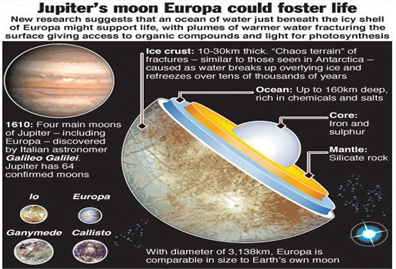Science and Technology
Context: According to a new study two alien planets about 218 light years away from Earth have found a twin in the ocean worlds of Europa and Enceladus — moons orbiting Jupiter and Saturn.
Highlights of the study:
- The exoplanets, Kepler-138 c and Kepler-138 d, are likely water worlds — a feature that scientists have theorised for a long time, the study published in the journal Nature Astronomy noted.
- They are also larger-scale versions of Enceladus (Saturn’s moon) and Europa (Jupiter’s moon), the findings predicted.
- The study reported that the Kepler- 138 c and d are made up of ingredients lighter than rock (rocky planets like Earth) but heavier than hydrogen or helium (gas-giant planets like Jupiter).
- The researchers also discovered a fourth planet in the Kepler planetary system: Kepler-138 e.
About Saturn:

- Saturn is the second largest planet of the solar system in mass and size and the sixth nearest planet in distance to the Sun.
- Saturn has an overall hazy yellow-brown appearance.
- Saturn’s atmosphere is composed mostly of molecular hydrogen and helium.
- Saturn has 83 moons with confirmed orbits that are not embedded in its rings.
- The moons of Saturn are numerous and diverse, ranging from tiny moonlets only tens of metres across to enormous Titan, which is larger than the planet Mercury.
- Saturn got its tilt due to gravitational interactions with its neighbour Neptune according to a well-known theory.
- But the new study argues that Saturn is no longer under Neptune’s gravitational influence.
- Titan, which is Saturn’s largest satellite, may have been responsible, suggested observations from NASA’s Cassini spacecraft, which orbited Saturn from 2004-2017.
- Titan’s fast migration caused the planet to tilt further, reducing Neptune’s gravitational influence on Saturn.
About Jupiter:

- Jupiter is the biggest planet in our solar system. It has big storms like the Great Red Spot, which has been going for hundreds of years.
- Jupiter is a gas giant and doesn’t have a solid surface, but it may have a solid inner core about the size of Earth. Jupiter also has rings, but they’re too faint to see very well.
- It is made mostly of hydrogen and helium.
- Jupiter has a very thick atmosphere.
- Jupiter has 79 confirmed moons.
- Jupiter is the fifth planet from the Sun. That means Mars and Saturn are Jupiter’s neighboring planets.
- Jupiter has been known since ancient times because it can be seen without advanced telescopes.
- Jupiter has been visited or passed by several spacecraft, orbiters and probes, such as Pioneer 10 and 11, Voyager 1 and 2, Cassini, New Horizons, and Juno.
Source: DownToEarth
Previous Year Questions
Q.1) Which one of the following is a reason why astronomical distances are measured in light-years? (2021)
- Distance among stellar bodies do not change
- Gravity of stellar bodies does not change
- Light always travels in straight line
- Speed of light is always same
Q.2) Recently, scientists observed the merger of giant ‘blackholes’ billions of light-years away from the earth. What is the significance of this observation? (2019)
- ‘Higgs boson particles’ were detected.
- ‘Gravitational waves’ were detected.
- Possibility of intergalactic space travel through ‘wormhole’ was confirmed.
- It enabled the scientists to understand ‘singularity’.













